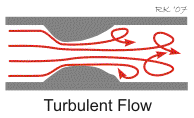 The Navier–Stokes equations describe turbulent flows, but, due to the properties of the flow, it is seldom possible to solve the equations for real engineering applications even with supercomputers. In a stirred-tank reactor the lifetime and size of the smallest turbulent eddies, the Kolmogorov scales, are about 5 ms and 50 µm, respectively. A very fine time and space resolution is needed when solving the Navier–Stokes equations and it is at present not possible. Direct solution of the Navier–Stokes equations (DNS) for small systems is, however, very useful for developing an understanding of turbulence, and for developing new models.
The Navier–Stokes equations describe turbulent flows, but, due to the properties of the flow, it is seldom possible to solve the equations for real engineering applications even with supercomputers. In a stirred-tank reactor the lifetime and size of the smallest turbulent eddies, the Kolmogorov scales, are about 5 ms and 50 µm, respectively. A very fine time and space resolution is needed when solving the Navier–Stokes equations and it is at present not possible. Direct solution of the Navier–Stokes equations (DNS) for small systems is, however, very useful for developing an understanding of turbulence, and for developing new models.
A more cost-effective method is to resolve only the large-scale turbulence, by filtering out the fine-scale turbulence, and model these small scales as flow-dependent effective viscosity. This method, large-eddy simulation (LES), is growing in popularity since it makes it possible to simulate simple engineering flows on a fast PC. The simulations are, however, very time consuming on a PC, and several weeks can often be needed to obtain good statistical averages even for rather simple flows.
For more complex flows, it is not possible to resolve the turbulence fluctuations at all. Most engineering simulations are done with Reynolds-averaged Navier–Stokes (RANS) methods.
In these models the turbulent fluctuations are time averaged, yet reasonable velocity averages can be simulated from these models. However, there are important properties of the flow that are not resolved. Everything that occurs on a scale below the size of the grid is not resolved, e.g. mixing of chemical species or the break-up and coalescence of bubbles and drops in multiphase flow. Additional models must be added to the RANS models in order to include these phenomena.
